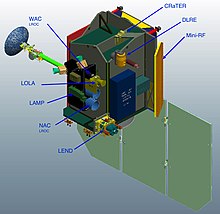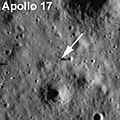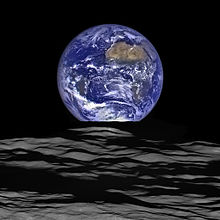Lunar Reconnaissance Orbiter
| Lunar Reconnaissance Orbiter | ||||||||||||||||||||||||||||
|---|---|---|---|---|---|---|---|---|---|---|---|---|---|---|---|---|---|---|---|---|---|---|---|---|---|---|---|---|
 Graphic representation of the Lunar Reconnaissance Orbiter in a lunar orbit |
||||||||||||||||||||||||||||
| NSSDC ID | 2009-031A | |||||||||||||||||||||||||||
| Mission goal | Earth moon | |||||||||||||||||||||||||||
| Client | NASA | |||||||||||||||||||||||||||
| Launcher | Atlas V | |||||||||||||||||||||||||||
| construction | ||||||||||||||||||||||||||||
| Takeoff mass | 1916 kg (of which 898 kg fuel) | |||||||||||||||||||||||||||
| Instruments | ||||||||||||||||||||||||||||
|
7th
|
||||||||||||||||||||||||||||
| Course of the mission | ||||||||||||||||||||||||||||
| Start date | June 18, 2009 | |||||||||||||||||||||||||||
| launch pad | Cape Canaveral AFS Launch Complex 41 | |||||||||||||||||||||||||||
|
||||||||||||||||||||||||||||
The Lunar Reconnaissance Orbiter (short LRO , Latin - English for moon -Aufklärungssonde ) is a lunar probe of NASA , which on 18 June 2009 at 21:32 UTC from Cape Canaveral Air Force Station Space Launch Complex 41 in conjunction with the LCROSS (LCROSS) started to the moon. The aim of the mission is the high-resolution mapping of the entire lunar surface ( topography , photography , indicators for the occurrence of water ice) and the measurement of cosmic radiation exposure. LRO is part of the Lunar Quest program to explore the moon.
mission
LRO should orbit the moon for at least one year in a comparatively low polar orbit at an altitude of 30 to 50 kilometers. A Delta II was to serve as the launch rocket for the probe, which initially weighed around 1,000 kilograms . In December 2005, NASA revised their original choice and decided to launch the probe with either a Delta IV or Atlas V , since Delta II only has a twist-stabilized upper stage, which did not meet the requirements for launching the LRO. On July 28, 2006, NASA announced that the launch would be on an Atlas-V (401) launcher .
Since the Atlas V is much stronger than the originally planned Delta II, the probe could be made around 1,000 kilograms heavier. This made it possible to take additional payloads such as an impactor, a lander or a separate communication microsatellite to the moon. After NASA had received several suggestions for additional payloads, the impactor variant in the form of the LCROSS mission was announced on April 10, 2006 as the final winner of this tender.
The Goddard Space Flight Center in Greenbelt, Maryland built the probe while the instruments were built by private companies. The budget for the entire mission, including LCROSS, is 583 million US dollars.
Until July 31, 2008 it was possible to submit your own name to NASA via the Internet. The names were stored on a chip in the Lunar Reconnaissance Orbiter and were thus on the probe when it orbited the moon.
50 targets on the lunar surface are recorded with special priority. This also includes the landing sites of various missions. Photographs of the Apollo landing sites should provide further knowledge of the geological environment in order to be able to classify the results of the Apollo program more precisely. The landing site of Lunochod 1 was also a target, since after almost a year of driving the rover, its final position was not exactly known. The "impact points" of failures should also be recorded. Just in time for the anniversary of the Apollo 11 landing on July 20, 2009, pictures of the landing site at Mare Tranquillitatis were published. Highly accurate images of the landing sites were published in September 2011. The images of the landing site of Apollo 17 also show the astronauts' footpaths, the lunar vehicle's lanes and the locations of scientific instruments.
instrumentation
With six different scientific devices, LRO examines the moon more closely than it has ever been studied before. A technology demonstration payload is also installed, which is a synthetic aperture radar developed by the US Department of Defense (see also Chandrayaan-1 ). A total of 685 watts of electrical power is available from the solar cells 4.3 by 3.2 meters in size and lithium-ion batteries with a capacity of 80 Ah. The data is transmitted in Ka-band (high-speed downlink with 100 Mb / s) and S-band (two-way).
- LOLA (Lunar Orbiter Laser Altimeter) is a lidar that is used to create a very precise topographic map of the moon. Because of the high albedo of water ice crystals, there is also the possibility of detecting surface ice in the polar regions .
- LROC (Lunar Reconnaissance Orbiter Cameras) creates both wide-angle images (Wide Angle Camera, WAC) and detailed images (Narrow Angle Camerae, NAC) of possible future landing sites. From the planned orbit height of 50 kilometers, the LROC has a resolution of 0.5 meters per pixel.
- LEND (Lunar Exploration Neutron Detector) counts neutrons emitted from the surface of the moon. This is used to search for water, because water absorbs neutrons. A reduced radiation in a certain area indicates water. LEND is developed by Igor Mitrofanov, of the Institute for Space Research, Federal Space Agency, in Moscow and is based on the HEND instrument of the Mars Odyssey probe.
- DLRE (Diviner Lunar Radiometer Experiment) maps the temperature of the lunar surface. This instrument is also used to search for water.
- LAMP (Lyman-Alpha Mapping Project) searches for ice deposits in the darkness of the permanently shadowed craters at the poles. It uses the reflection of starlight in the range of ultraviolet radiation.
- CRaTER (Cosmic Ray Telescope for the Effects of Radiation) measures the possible biological effect of cosmic radiation .
- Mini-RF is a technology demonstration of a single aperture radar (SAR) operating in the X-band and S-band . Mini-RF is used to demonstrate the new lightweight SAR, communication technologies and locate any water ice that may be present.
Mission history

The LRO took off together with LCROSS on June 18, 2009 at 21:32 UTC on an Atlas V rocket. This brought the probes into a temporary parking orbit around the earth. After 24 minutes, the engines of the Centaur upper stage were ignited again , which brought the combination in a highly elliptical orbit towards the moon. Shortly thereafter, the missile was rotated 180 degrees and the LRO released. On June 23 at 09:47 UTC, the engine was fired for 40 minutes to slow the probe down so that it swiveled into a polar lunar orbit. Four more engine firings in the course of the following five days changed the orbit from initially 220 kilometers to 3,100 kilometers to 31 kilometers (South Pole) to 199 kilometers. In this orbit, all instruments were put into operation and calibrated. During this roughly 60-day phase, the altitude was also reduced to around 50 kilometers. The probe has been mapping the moon since then and collecting data on resources and radiation exposure on the moon. The mission is supposed to end with a targeted impact on the moon.
The first pictures of the LROC were published on July 2nd, 2009. On July 17, 2009 NASA published pictures of five of the six landing sites of the Apollo program , on which the lower stages of the lunar lander that remained on the moon can be seen. Due to the low position of the sun, the lower levels of the lunar modules can be seen in the pictures, especially through the long shadow.
In September 2011, NASA published a video showing the landing sites of Apollo 12, 14 and 17 in an even higher resolution. In March 2012, the first photo of the Apollo 11 landing site from final orbit and an altitude of 15 miles was released. In addition to the landing module and scientific equipment, the astronauts' footprints can also be seen on it.
- LRO images of landing sites
Apollo 11 , high resolution image from March 2012
The operation of the probe was extended by two years on September 17, 2012 and September 16, 2014. On May 4, 2015, it was maneuvered to a lower orbit: 20 km (South Pole) to 165 km (North Pole). She can work on this for many years. The investigation conditions are improved by the shorter distance to the lunar surface. This applies significantly to the LOLA and Diviner instruments in the area of the South Pole.
Based on the famous Earthrise image , NASA published a new high-resolution photo of the earth with the moon in the foreground in December 2015. The image was compiled from several individual images and then digitally processed.
On September 16, 2016, the mission was extended for another three years. A fourth extension was requested in 2019 because the fuel will last for another seven years.
See also
- Chronology of the moon missions
- List of man-made objects on the moon
- Moon cards , selenodesia
- Manned moon flight to Apollo
Web links
- Arizona State University: Lunar Reconnaissance Orbiter Camera (English)
- NASA: Lunar Reconnaissance Orbiter (English)
- NSSDC: Lunar Reconnaissance Orbiter (English)
- Raumfahrer.net: LRO and LCROSS: NASA returns to the moon
- NASA: Mission News Feed
Individual evidence
- ^ LRO Launch Information. NASA, June 15, 2009, accessed September 9, 2013 .
- ↑ Lunar Quest Homepage. NASA, accessed September 9, 2013 .
- ^ George H. Diller: NASA Awards Launch Services for Lunar Mission. NASA, July 28, 2006, accessed September 9, 2013 .
- ^ New NASA Ames Spacecraft to Look for Ice at Lunar South Pole. NASA, April 10, 2006, accessed September 9, 2013 .
- ↑ http://news.cnet.com/8301-19514_3-10268241-239.html
- ↑ a b LRO Lake's Apollo Landing Sites. NASA, July 19, 2009, accessed September 9, 2013 .
- ↑ Tracks on the moon. Süddeutsche Zeitung1, September 9, 2011, accessed on September 9, 2013 .
- ^ Lunar Reconnaissance Orbiter Camera. Malin Space Science Systems, accessed September 9, 2013 .
- ↑ Lunar Reconnaissance Orbiter Camera: What is LROC? Arizona State University, accessed September 9, 2013 .
- ↑ Lunar Reconnaissance Orbiter: Spacecraft & Instruments. NASA, accessed September 9, 2013 .
- ↑ We are there !!! LRO Team, June 23, 2009, accessed September 9, 2013 .
- ↑ LRO's First Moon Images. NASA, July 2, 2009, accessed September 9, 2013 .
- ^ New LRO Images Offer Sharper Views of Apollo Sites. NASA, September 6, 2011, accessed September 9, 2013 .
- ↑ Apollo 11: 'A Stark Beauty All Its Own'. NASA, March 13, 2012, accessed September 9, 2013 .
- ^ A b J. W. Keller and NE Petro: The Cornerstone Mission: A Third Extension of the Lunar Reconnaissance Orbiter Mission. (PDF) NASA, 2018, accessed April 14, 2019 .
- ↑ NASA's LRO Moves Closer to the Lunar Surface. Retrieved June 1, 2015 .
- ↑ NASA: NASA Reflects on Legacy of LRO as Moon-Orbiting Mission Reaches 10-Year Anniversary. June 18, 2019, accessed on December 21, 2019 : "We've just submitted our fourth extended mission proposal"
- ↑ Stephen Clark: 10 years since its launch, NASA lunar orbiter remains crucial for moon landings. Spacefkight Now, June 18, 2019, accessed on December 21, 2019 : "There's enough propellant left on LRO to continue the mission for at least seven more years"









